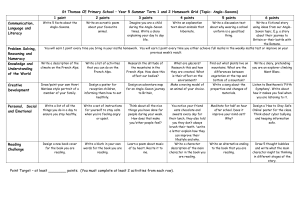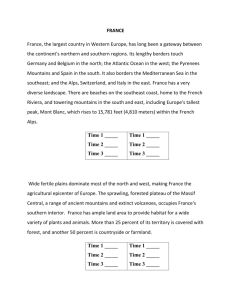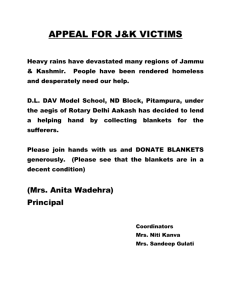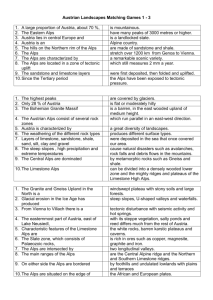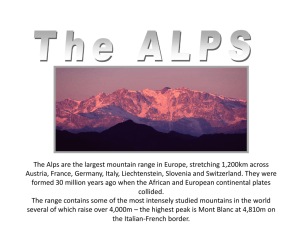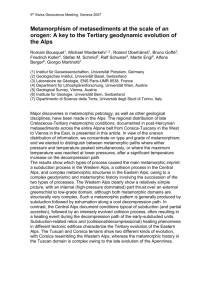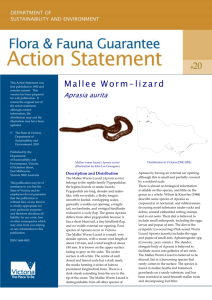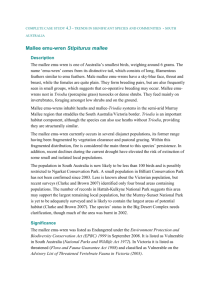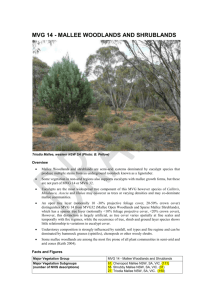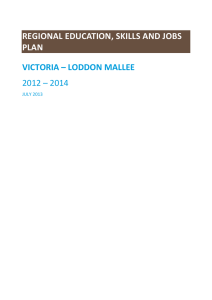SAFETY IN THE MALLEE/Grampians Courses Notes First aid Keep
advertisement
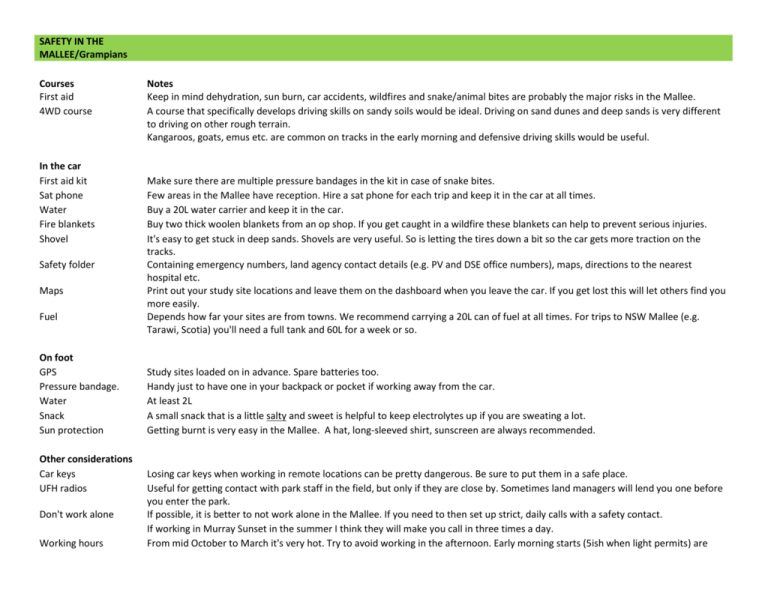
SAFETY IN THE MALLEE/Grampians Courses First aid 4WD course In the car First aid kit Sat phone Water Fire blankets Shovel Safety folder Maps Fuel On foot GPS Pressure bandage. Water Snack Sun protection Other considerations Car keys UFH radios Don't work alone Working hours Notes Keep in mind dehydration, sun burn, car accidents, wildfires and snake/animal bites are probably the major risks in the Mallee. A course that specifically develops driving skills on sandy soils would be ideal. Driving on sand dunes and deep sands is very different to driving on other rough terrain. Kangaroos, goats, emus etc. are common on tracks in the early morning and defensive driving skills would be useful. Make sure there are multiple pressure bandages in the kit in case of snake bites. Few areas in the Mallee have reception. Hire a sat phone for each trip and keep it in the car at all times. Buy a 20L water carrier and keep it in the car. Buy two thick woolen blankets from an op shop. If you get caught in a wildfire these blankets can help to prevent serious injuries. It's easy to get stuck in deep sands. Shovels are very useful. So is letting the tires down a bit so the car gets more traction on the tracks. Containing emergency numbers, land agency contact details (e.g. PV and DSE office numbers), maps, directions to the nearest hospital etc. Print out your study site locations and leave them on the dashboard when you leave the car. If you get lost this will let others find you more easily. Depends how far your sites are from towns. We recommend carrying a 20L can of fuel at all times. For trips to NSW Mallee (e.g. Tarawi, Scotia) you'll need a full tank and 60L for a week or so. Study sites loaded on in advance. Spare batteries too. Handy just to have one in your backpack or pocket if working away from the car. At least 2L A small snack that is a little salty and sweet is helpful to keep electrolytes up if you are sweating a lot. Getting burnt is very easy in the Mallee. A hat, long-sleeved shirt, sunscreen are always recommended. Losing car keys when working in remote locations can be pretty dangerous. Be sure to put them in a safe place. Useful for getting contact with park staff in the field, but only if they are close by. Sometimes land managers will lend you one before you enter the park. If possible, it is better to not work alone in the Mallee. If you need to then set up strict, daily calls with a safety contact. If working in Murray Sunset in the summer I think they will make you call in three times a day. From mid October to March it's very hot. Try to avoid working in the afternoon. Early morning starts (5ish when light permits) are Getting lost Recovery gear Traffic Dehydration Fire best. It's easy to get lost in the Mallee. The best thing to do when you’re lost is to sit down in the shade and look at your maps/GPS. Sometimes it's possible to retrace your steps in the sand - but don't rely on this. it's useful to record which side of the road your working on and which direction you would roughly need to travel to get back their (e.g. east or west). A hand winch is useful to have but probably not necessary. If you really get in trouble (and can't get out with a shovel) then you have your sat phone Watch out for dirt bikes and 4wd groups on the weekends. Particularly in Murray Sunset. Remember that dehydration does not only refer to loosing fluids but also electrolytes. Make sure you are eating well (including SALTS and sugars) or add Hydrolyte/Gatorade to your fluids. Under the CFA fire index of catastrophic/extreme fire weather conditions, make sure you use common sense. The general rule is not to go out in these conditions. *DSE and Parks Vic will also have safety protocols in place e.g. having to contact them three times a day while you're in the park. Check requirements with them well in advance. SAFETY IN THE ALPS: Vic. High Country Courses First aid 4WD course In the car First aid kit Sat phone* Water Fire blankets Safety folder Maps Fuel Notes Keep in mind dehydration, cold/fog/lightning, sun burn, car accidents, wildfires and snake/animal bites are probably the major risks in the Alps. Most tracks are well made but there are some situations where they are not. You should be confident on how to drive them. Make sure there are multiple pressure bandages in the kit in case of snake bites. Most areas in the Alps have mobile reception but there are patches without. A Sat phone may be required when much of the fieldwork is in these areas with no reception. All networks have coverage in the vicinity of Falls Creek, outside that area the level of reception is dependent on network provider. Telstra generally has the best reception in these areas. Buy a 10L water carrier and keep it in the car. Buy two thick woolen blankets from an op shop. If you get caught in the cold or in a wildfire these blankets can help to prevent serious injuries. Containing emergency numbers, land agency contact details (e.g. PV and DSE office numbers), maps, directions to the nearest hospital etc. Print out your study site locations and leave them on the dashboard when you leave the car. If you get lost this will let others find you more easily. A can of extra fuel is not normally required as towns are never too far away, however since the alpine villages e.g. Falls Creek do not have a public petrol station you must be careful to keep an eye on the tank level. The closest petrol station is at Mount Beauty. Closest Shell service stations are in Bright & Mrytleford (for Falls Creek). On foot GPS Map Pressure bandage. Water Snack Sun protection Raincoat and pants Jumper/jacket Other considerations Car keys UFH radios Don't work alone Getting lost Recovery gear Weather - Lightning - Fog Fire Study sites loaded on in advance. Spare batteries too. Map of area with contour lines and tracks marked. Compass. Handy just to have one in your backpack or pocket if working away from the car. At least 2L should be with you at all times. However many areas in the alpine national park have small permanent running streams which are safe to drink from. Good to have something in case you get lost or are out for a long time Getting burnt is very easy in the alps. A hat, long-sleeved shirt, sunscreen are always recommended. Always carry wet weather gear when working away from the car. The weather can turn extremely quickly; a sunny day can get very, very cold. Losing car keys when working in remote locations can be pretty dangerous. Be sure to put them in a safe place. Useful for getting contact with park staff in the field, but only if they are close by. If possible, do not work alone in the Alps. If you need to, then set up strict, daily calls with a safety contact. It's easy to get lost in the Alps. The best thing to do when you’re lost is to sit down, keep warm, and look at your maps/GPS. It's useful to record which side of the road your working on and which direction you would roughly need to travel to get back their (e.g. east or west), or take a waypoint of your car if you are going off road. This is particularly important if going out in a ‘white out’. Generally not required in the Alps The weather can change very quickly and is the greatest risk when working in the alps. It is always recommended to check the forecast prior to the start of each day. Cold weather, snow and rain are common, but it is the wind chill that is most dangerous. Make sure you have a windproof layer (e.g. rain jacket, waterproof pants, thick plastic bag) handy if this happens. Thunderstorms can also build up very quickly and occur at anytime of the year. If you are out in the field and such a storm is building it is highly recommended to stop what you are doing and come back to it after the storm has past. You are often the tallest object and likely to get hit. People doing fieldwork have been hit before so be careful! Lastly, there are occasional days where it is very foggy and visibility is low (i.e. a white out). It is recommended that under such conditions you do not venture out unless sites are close to the road. Fog often dissipates by noon, but can persist for the entire day. People often get lost under these conditions. If you must go out make sure you take a GPS & compass. Waypoint where your car is as well as the general direction (in case you GPS fails). Under catastrophic/extreme fire weather conditions make sure you use common sense. The general rule is not to go out. However, the fire index used by the CFA is primarily in relation to lowland areas, with fires beginning or burning up into the alpine environment being relatively rare. *DSE and Parks Vic may also have safety protocols in place. Check requirements with them well in advance.
